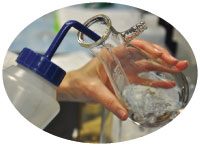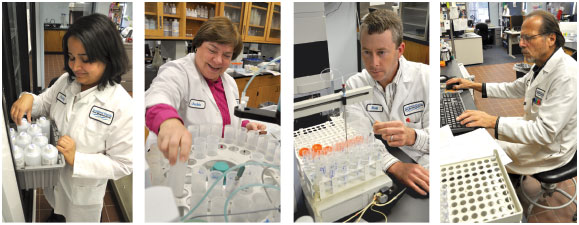Left to right: Pinky Mathew retrieves samples from storage. Jackie Robbins prepares samples for testing for alkalinity concentrations. Matt Jablonski loads the auto sampler for the Inductively Coupled Plasma Spectrophotometer. Ron Lubosco configures the auto analyzer that tests for nitrogen concentrations.
The District’s chemistry laboratory recently ranked No. 1 overall in a study that tested the quality of several laboratories in the southeast region of the United States.
The volunteer study compared the chemistry laboratories at 14 agencies from states bordering the Gulf of Mexico.
“We participate in these round-robin studies as part of our certification process,” said Mark Rials, District chemistry laboratory manager. “They help improve our ability to generate consistent quality data.”
Participating labs receive water samples with instructions on what types of tests to run. The labs have to determine the type of water in each sample, perform the proper testing protocol and return accurate analysis results for comparison.
Labs from the five states bordering the Gulf of Mexico regularly compare results in these round-robin studies. Florida state agency labs performed well in this study. The South Florida Water Management District and the Florida Department of Environmental Protection also ranked in the top three.
The District’s 11-member chemical laboratory tests 3,000 to 4,000 water samples each year. “We focus primarily on high-efficiency, high-productivity tests,” said Rials. “We test for metals, physical parameters, solids, color, turbidity, nutrients, sulfate, ions and some others.”
The District relies on the lab to test surface water and wells to monitor nutrient levels, measure clarity and identify potential issues, such as saltwater intrusion within the aquifer. The lab outsources many of the tests that are infrequently needed.
“We could do everything,” said Rials, “but it’s much more cost-effective to outsource tests we don’t need very often. Maintaining equipment, training and certifications required to perform tests that aren’t often needed is much more expensive than outsourcing.”
The District’s lab is certified in accordance with the National Environmental Laboratory Accreditation Conference standard in 36 parameters and two categories. It operates based on a set level of quality measures in accordance with the conference. To maintain the accreditation, the lab undergoes site inspections every two years by the state of Florida.


